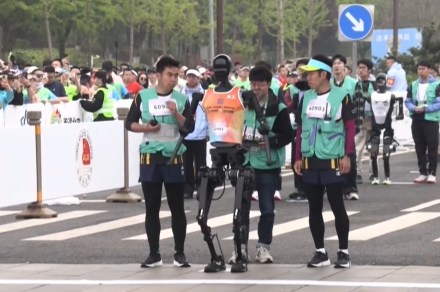Screenshot
Perhaps you’ve seen robots dance like music icon Mick Jagger or do parkour. Or maybe they painted on a canvas. Tesla’s Optimus robot is highly anticipated, and Google and Meta plan to enter the market as well. The competition in East is on a completely different level.
China has just put humanoid robotics to the test, in the first race of this kind in the world. They ran alongside humans in an half-marathon. After a long period of learning under supervision on roads, 21 robots were ready for the race in Yizhuang.
A whole bunch of robotics firms showcased their wares at the event. Some robots were only 3.9 feet tall, while others reached a height of 5.9 foot. Some fell, some tried to stand up on their own and a few needed human assistance.
The humanoid robots navigated steep slopes and potholes as well as smooth asphalt during the race. Batteries could be swapped, but replacing them would result in a steep fine. Robotics and software experts intervened, but not all robots reached the finish line.
Did the robots beat the humans?
No, not really. And the gap was also huge. The human winner finished the half-marathon within an hour while the humanoid robot won took 2 hours 40 minutes to reach finish line.
This is an average speed of 4,89 miles per hour. Comparatively, Usain Bolt, the Olympic champion in 2011, reached a top speed at 27.33 miles an hour during a track competition. The point was not to beat a human runner.
The engine team’s expectations were exceeded by about a half-hour.
In China, the half-marathon was more of a showcase for the robotics companies in the country. Beijing Innovation Center of Human Robotics developed the Tiangong Ultra robot, the winner of the humanoid competition.
A landmark achievement
Tang Jian, the head of the company that created the winning robot was quoted by
Reuters.
This is a state-backed firm in which Chinese electronics giant Xiaomi also holds a significant stake. According to
SCMPis a company that aims to be “the Android of humanoid robotics”. For the half-marathon some modification work was done to get the most performance.
We lightened the robot while maintaining its strength. We refined its leg design and improved its thermal conductivity, air-cooling and endurance systems.
Xinhua.
The organizers and participating companies behind the half-marathon note that the ultimate aim is to showcase humanoid robotics in human environments. They will soon move from design labs into industrial settings, but their ultimate goal is to be a helpful home assistant for the average person.
Nadeem is a tech and science journalist who started reading about cool smartphone tech out of curiosity and soon started…
Google Gemini’s best AI tricks finally land on Microsoft Copilot
Microsoft’s Copilot had a rather splashy AI upgrade fest at the company’s recent event. Microsoft made a total of nine product announcements, which include the agentic trick called Actions, Memory, Vision, Pages, Shopping, and Copilot Search.
A healthy few have already appeared on rival AI products such as Google’s Gemini and OpenAI’s ChatGPT, alongside much smaller players like Perplexity and browser-maker Opera. However, two products that have found some vocal fan-following with Gemini and ChatGPT have finally landed on the Copilot platform.
Rivian to unlock unmapped routes for Gen2 vehicles.
.
Rivian Fans rejoice! Rivian’s second-gen R1 cars received a game-changing update that enabled automated, hands-off, driving. The new feature, which only works on highways that are mapped, has left many fans wanting more.
The company, which prides themselves on listening to its customers and delivering what they want, has announced that a’map free’ upgrade will be available in the second half of this year.
James Philbin, Rivian’s VP of autonomy said on the podcast RivianTrackr hangouts that customers have told them they love [Highway Assist] and want to use it more often. “We’re working on something exciting, we call it internally ‘Map Free,’ that we plan to release later this year.” These events are used by Rivian to train its offline model in the Cloud before data is distilled to individual vehicles.
Rivian’s founder and CEO RJ scaringe explained early March that HWA was the beginning of an expanding set of automated-driving features, “going from highways, to surface roads, to turning-by-turn.” For now, HWA requires drivers to keep their eye on the road. The system will send you alerts if your drift is too long. Stay tuned, eyes-off driving will be available in 2026.
This is also part of Rivian’s “Giving You Your Time Back” philosophy. It’s the first of three pillars that will support Rivian vision for the next three to five year. Philbin says the philosophy is based on “meeting customers where they are” rather than chasing full automation as other automakers such as Tesla’s Robotaxi might be doing.
We recognize that many people buy Rivians in order to go on these adventures and have these amazing journeys. Philbin says, “They want to drive and we want them to drive.” “But there are other driving situations that are very monotonous and boring, such as on the highway. We can provide the best experience by giving you back your time.
This is also what will eventually lead to the third and final pillar of Rivian’s vision: Level 4 or high-automation cars. These will have features like auto park or valet where you can leave your Rivian in the office or at the airport and it will park itself. Philbin, while not making any promises, believes that the Gen 2 hardware and platform should be able support these new features.
The focus of Rivian’s second pillar is on active safety features. Rivian rewrote their entire autonomous vehicle (AV), system for their Gen2 models. This focus has allowed Rivian to have its R1T be the only large truck to receive a Top Safety Pick+ award from the Insurance Institute for Highway Safety.
Philbin says, “I think there’s a great deal of innovation in active safety in terms of making these features more capable and preventing accidents.” Jaguar Land Rover and Nissan halt shipments to U.S. due to tariffs
Jaguar Land Rover has announced that it will pause the shipment of its UK-made vehicles to the United States in this month while it determines how to respond President Donald Trump’s 25% import tariff on cars. JLR sent a press release to various media.
Read More





